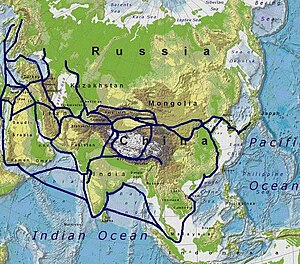History of Asia
From Wikipedia, the free encyclopedia
The Silk Road connected many civilizations across Asia.[1]
Asia in 1200 CE, just before the Mongol Empire
The coastal periphery was the home to some of the world's earliest known civilizations, with each of the three regions developing early civilizations around fertile river valleys. These valleys were fertile because the soil there was rich and could bare lots of root crops. The civilizations in Mesopotamia, the Indus Valley, and China shared many similarities and likely exchanged technologies and ideas such as mathematics and the wheel. Other notions such as that of writing likely developed individually in each area. Cities, states and then empires developed in these lowlands.
The steppe region had long been inhabited by mounted nomads, and from the central steppes they could reach all areas of the Asian continent. The northern part of the continent, covering much of Siberia was also inaccessible to the steppe nomads due to the dense forests and the tundra. These areas in Siberia were very sparsely populated.
The centre and periphery were kept separate by mountains and deserts. The Caucasus, Himalaya, Karakum Desert, and Gobi Desert formed barriers that the steppe horsemen could only cross with difficulty. While technologically and culturally the city dwellers were more advanced, they could do little militarily to defend against the mounted hordes of the steppe. However, the lowlands did not have enough open grasslands to support a large horsebound force. Thus the nomads who conquered states in China, India, and the Middle East were soon forced



No comments:
Post a Comment